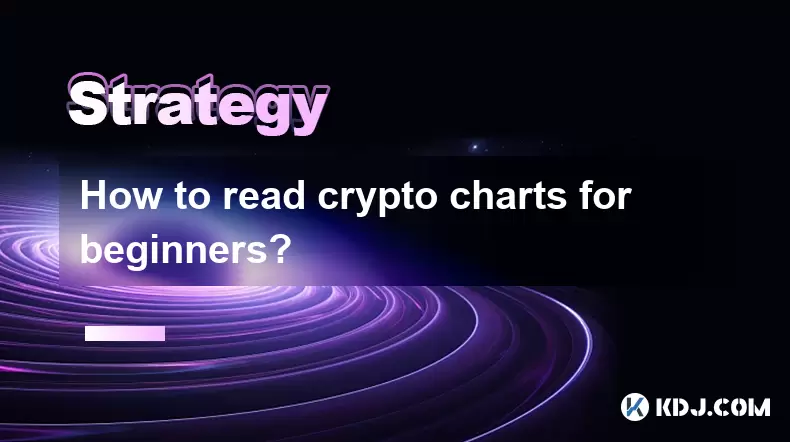-
 bitcoin
bitcoin $120167.907534 USD
1.27% -
 ethereum
ethereum $4468.611945 USD
2.53% -
 xrp
xrp $3.013607 USD
1.80% -
 tether
tether $1.000549 USD
-0.01% -
 bnb
bnb $1092.592149 USD
6.28% -
 solana
solana $231.391244 USD
4.59% -
 usd-coin
usd-coin $0.999699 USD
-0.04% -
 dogecoin
dogecoin $0.259020 USD
4.30% -
 tron
tron $0.342747 USD
0.34% -
 cardano
cardano $0.860977 USD
1.07% -
 hyperliquid
hyperliquid $50.155412 USD
5.34% -
 chainlink
chainlink $22.637678 USD
0.46% -
 ethena-usde
ethena-usde $1.000528 USD
-0.07% -
 avalanche
avalanche $30.613779 USD
-0.07% -
 stellar
stellar $0.403905 USD
0.94%
How to read crypto charts for beginners?
Learn to read crypto charts using candlestick patterns, support/resistance levels, and indicators like RSI and moving averages for better trading decisions.
Jul 13, 2025 at 01:42 pm

Understanding the Basics of Crypto Charts
To begin learning how to read crypto charts, it is essential to understand what they represent. Crypto charts are graphical representations of a cryptocurrency’s price movements over time. These charts help traders and investors make informed decisions by analyzing historical data. Most platforms use candlestick charts, which provide more information than simple line or bar charts. Each candlestick shows the open, high, low, and close prices for a specific time frame.
The body of the candlestick represents the range between the opening and closing prices. If the closing price is higher than the opening price, the candle is usually green or hollow, indicating a bullish trend. Conversely, if the closing price is lower than the opening price, the candle is typically red or filled, showing a bearish trend. The wicks or shadows on either end of the candle show the highest and lowest prices reached during that time period.
Choosing the Right Time Frame
One of the first decisions you’ll need to make when reading crypto charts is choosing the appropriate time frame. Different time frames can drastically change how a chart looks and how trends appear. For beginners, it's recommended to start with longer time frames such as daily (1D) or 4-hour (4H) intervals before diving into shorter ones like 15-minute or 1-hour charts.
- Daily charts provide a broader view of price action, making them suitable for long-term investors.
- 4-hour charts offer a balance between detail and clarity, ideal for identifying medium-term trends.
- Shorter time frames like 1-hour or 15-minute charts are used by day traders who aim to capture small price movements.
Selecting the right time frame depends on your trading strategy and goals. Beginners should focus on understanding patterns in larger time frames before attempting to trade based on smaller fluctuations.
Identifying Key Chart Patterns
Once you're comfortable with the structure of candlesticks and time frames, you can begin recognizing common chart patterns. These patterns help predict future price movements based on historical behavior. Some of the most widely followed patterns include:
- Support and Resistance Levels: Horizontal lines where the price has historically bounced off. Support is a level where buying pressure tends to overcome selling pressure, while resistance is where selling pressure typically outweighs buying pressure.
- Trendlines: Diagonal lines connecting highs or lows to indicate the direction of a trend. An uptrend is formed by connecting rising lows, while a downtrend connects falling highs.
- Head and Shoulders: A reversal pattern consisting of three peaks, where the middle peak (head) is higher than the two surrounding peaks (shoulders).
- Double Top and Double Bottom: Reversal patterns signaling potential trend changes. A double top occurs after an uptrend and resembles an 'M', while a double bottom appears after a downtrend and looks like a 'W'.
Recognizing these patterns takes practice, but they are crucial tools for interpreting market sentiment and making educated predictions.
Using Technical Indicators Effectively
In addition to chart patterns, traders often rely on technical indicators to gain deeper insights into price action. These are mathematical calculations plotted on the chart to help identify trends, momentum, volume, and volatility. Some beginner-friendly indicators include:
- Moving Averages (MA): Smooth out price data to show trends more clearly. The Simple Moving Average (SMA) and Exponential Moving Average (EMA) are commonly used. When the price crosses above a moving average, it may signal a bullish trend; crossing below could indicate a bearish one.
- Relative Strength Index (RSI): Measures the speed and change of price movements to determine overbought or oversold conditions. An RSI above 70 suggests overbought conditions, while below 30 indicates oversold.
- Bollinger Bands: Consist of a middle moving average and two standard deviation bands above and below. Prices near the upper band may suggest overbought conditions, while those near the lower band might be oversold.
- Volume: Shows the number of coins traded within a given time frame. Increasing volume during a price rise confirms strength in the trend.
Beginners should experiment with different indicators to see which ones align best with their trading style. It’s also important not to overload the chart with too many indicators, as this can lead to confusion.
Setting Up Your First Chart Analysis Session
Now that you’re familiar with the components of crypto charts, it's time to put your knowledge into practice. Start by selecting a reliable platform such as TradingView, CoinMarketCap, or Binance. Ensure the platform allows customization of time frames, indicators, and drawing tools.
Here’s how to set up your first chart analysis session:
- Choose a cryptocurrency you want to analyze. Popular options for beginners include Bitcoin (BTC) and Ethereum (ETH) due to their high liquidity and availability of data.
- Select a time frame that matches your trading horizon—start with daily or 4-hour charts.
- Add at least one moving average and RSI to your chart for basic technical analysis.
- Use the drawing tools to mark support/resistance levels and trendlines.
- Observe how price interacts with these levels and indicators over time.
Keep a journal of your observations and revisit previous analyses to assess accuracy. This will help refine your ability to interpret crypto charts effectively.
Frequently Asked Questions
Q: Can I rely solely on crypto charts for investment decisions?A: While charts are valuable tools, they should be used alongside fundamental analysis and news events. Markets can be influenced by external factors such as regulatory changes, macroeconomic developments, and technological updates.
Q: What is the best platform for beginners to practice reading crypto charts?A: TradingView is highly recommended for beginners due to its user-friendly interface, customizable features, and community-driven insights. Many exchanges also offer built-in charting tools with basic functionalities.
Q: How do I know if a trend is about to reverse?A: Watch for key reversal patterns like head and shoulders, double tops/bottoms, and trendline breaks. Additionally, divergence between price and momentum indicators like RSI or MACD can signal potential reversals.
Q: Is it possible to automate chart analysis using bots or software?A: Yes, there are automated trading systems and bots that use predefined rules based on technical indicators and chart patterns. However, beginners are advised to fully understand manual chart reading before exploring automation.
Disclaimer:info@kdj.com
The information provided is not trading advice. kdj.com does not assume any responsibility for any investments made based on the information provided in this article. Cryptocurrencies are highly volatile and it is highly recommended that you invest with caution after thorough research!
If you believe that the content used on this website infringes your copyright, please contact us immediately (info@kdj.com) and we will delete it promptly.
- BlockDAG, DOGE, HYPE Sponsorship: Crypto Trends Shaping 2025
- 2025-10-01 00:25:13
- Deutsche Börse and Circle: A StableCoin Adoption Powerhouse in Europe
- 2025-10-01 00:25:13
- BlockDAG's Presale Buzz: Is It the Crypto to Watch in October 2025?
- 2025-10-01 00:30:13
- Bitcoin, Crypto, and IQ: When Genius Meets Digital Gold?
- 2025-10-01 00:30:13
- Stablecoins, American Innovation, and Wallet Tokens: The Next Frontier
- 2025-10-01 00:35:12
- NBU, Coins, and Crypto in Ukraine: A New Yorker's Take
- 2025-10-01 00:45:14
Related knowledge

Practical parameter settings for a Bitcoin multi-timeframe moving average system
Sep 18,2025 at 10:54pm
Optimizing Timeframe Combinations for Bitcoin Trading1. Selecting appropriate timeframes is crucial when building a multi-timeframe moving average sys...

How can I filter out false breakouts in Dogecoin high-frequency trading?
Sep 22,2025 at 01:00am
Understanding False Breakouts in Dogecoin Trading1. A false breakout occurs when Dogecoin's price appears to move beyond a defined support or resistan...

Techniques for identifying tops and bottoms in the Bitcoin on-chain NVT model
Sep 20,2025 at 07:54pm
Understanding the NVT Model in Bitcoin Analysis1. The Network Value to Transactions (NVT) ratio is often described as the 'P/E ratio' of the cryptocur...

What does the surge in open interest in Bitcoincoin futures mean?
Sep 20,2025 at 11:18pm
Understanding the Surge in Dogecoin Futures Open Interest1. A surge in open interest within Dogecoin futures indicates a growing number of active cont...

How can I use the Ethereum USDT premium to gauge market sentiment?
Sep 18,2025 at 11:55pm
Understanding the Ethereum USDT Premium1. The Ethereum USDT premium refers to the price difference between USDT (Tether) traded on Ethereum-based plat...

What should I do if Ethereum staking yields decline?
Sep 20,2025 at 06:18am
Understanding the Causes Behind Declining Ethereum Staking Yields1. The Ethereum network transitioned to a proof-of-stake consensus mechanism with the...

Practical parameter settings for a Bitcoin multi-timeframe moving average system
Sep 18,2025 at 10:54pm
Optimizing Timeframe Combinations for Bitcoin Trading1. Selecting appropriate timeframes is crucial when building a multi-timeframe moving average sys...

How can I filter out false breakouts in Dogecoin high-frequency trading?
Sep 22,2025 at 01:00am
Understanding False Breakouts in Dogecoin Trading1. A false breakout occurs when Dogecoin's price appears to move beyond a defined support or resistan...

Techniques for identifying tops and bottoms in the Bitcoin on-chain NVT model
Sep 20,2025 at 07:54pm
Understanding the NVT Model in Bitcoin Analysis1. The Network Value to Transactions (NVT) ratio is often described as the 'P/E ratio' of the cryptocur...

What does the surge in open interest in Bitcoincoin futures mean?
Sep 20,2025 at 11:18pm
Understanding the Surge in Dogecoin Futures Open Interest1. A surge in open interest within Dogecoin futures indicates a growing number of active cont...

How can I use the Ethereum USDT premium to gauge market sentiment?
Sep 18,2025 at 11:55pm
Understanding the Ethereum USDT Premium1. The Ethereum USDT premium refers to the price difference between USDT (Tether) traded on Ethereum-based plat...

What should I do if Ethereum staking yields decline?
Sep 20,2025 at 06:18am
Understanding the Causes Behind Declining Ethereum Staking Yields1. The Ethereum network transitioned to a proof-of-stake consensus mechanism with the...
See all articles










































































